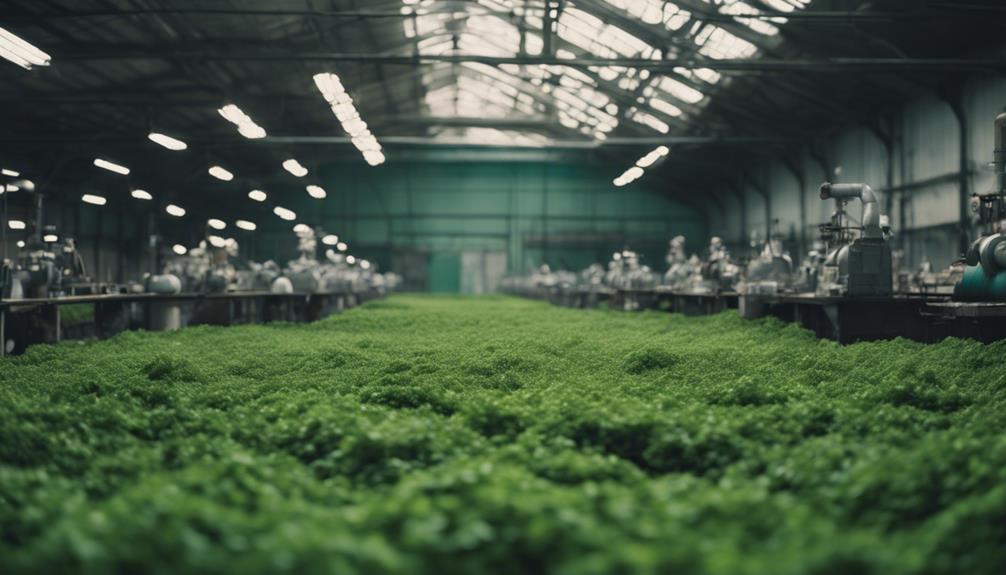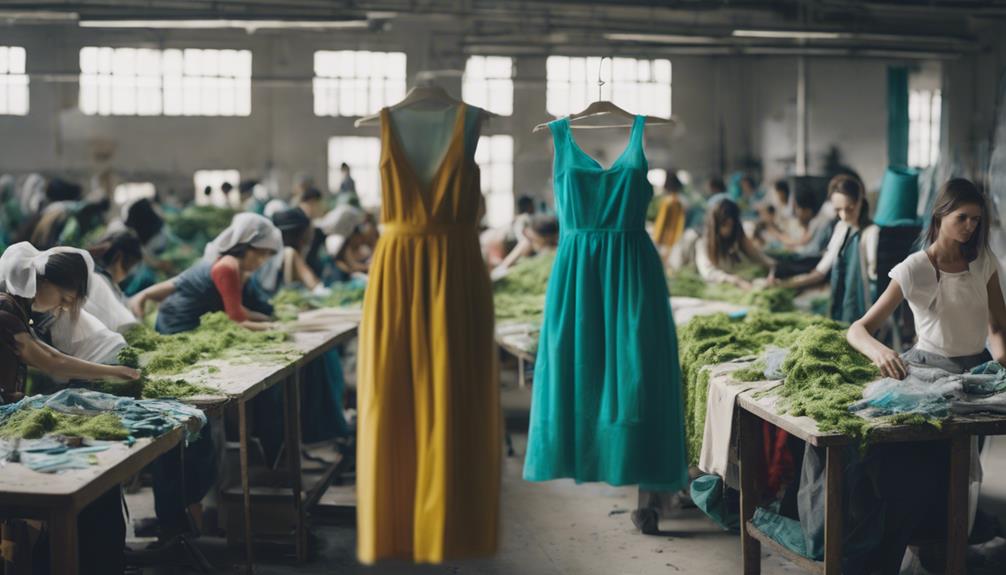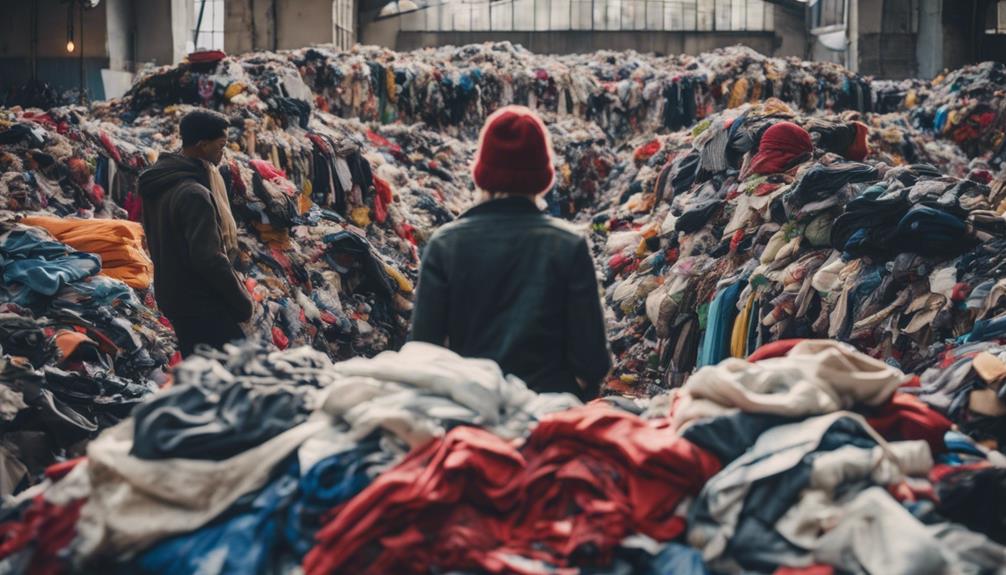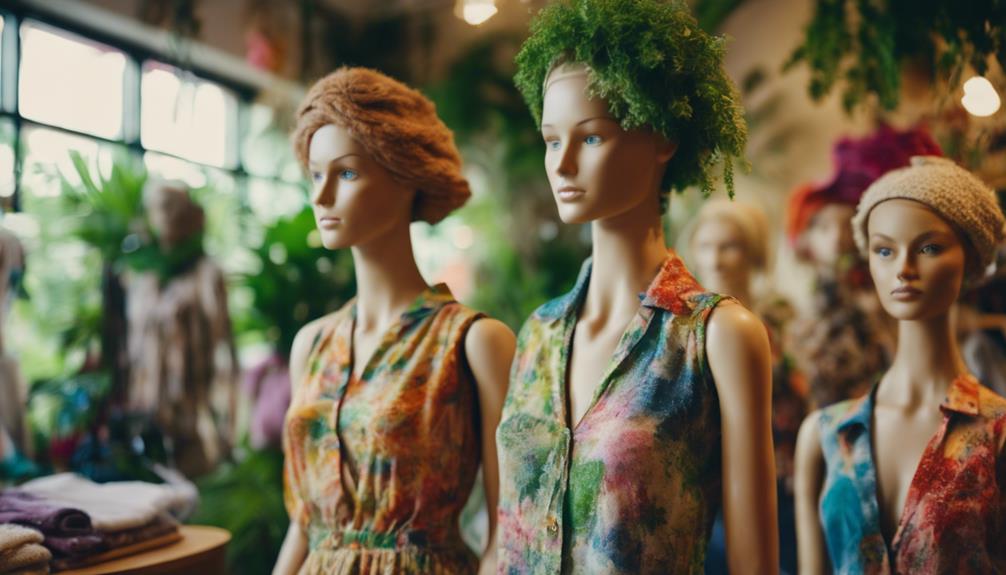Sustainable fashion is not just about trendy clothing; it is a significant movement that has a major impact on the world. The fashion industry is known for its harmful environmental effects, with fast fashion leading to millions of tons of waste and significant carbon emissions each year. Despite claims of being eco-friendly, many brands still use harmful materials and practices. Consumer awareness is crucial in driving demand for true sustainability. You have the power to support ethical brands and bring about change. As you delve deeper, you will realize how your choices can help create a brighter, more sustainable future in fashion and beyond.
Key Takeaways
- The fashion industry contributes significantly to pollution, with fast fashion generating 500 million kg of textile waste annually in Canada alone.
- Fast fashion is responsible for 10% of global carbon emissions, exacerbating climate change and environmental degradation worldwide.
- The garment industry accounts for 20% of global wastewater, consuming 93 billion cubic meters of water yearly for fabric dyeing.
- Ethical consumption can combat labor rights violations, as many workers face exploitation and unsafe conditions in developing countries.
Industry Claims Vs. Reality
When you dig into the fashion industry's sustainability claims, you'll often find a stark contrast between marketing hype and the actual environmental impact. Despite brands flaunting their sustainability credentials, the reality is that the industry's environmental footprint has barely changed in the past 25 years. Most products are still crafted from non-biodegradable, petroleum-based materials, which raises serious questions about the authenticity of these claims.
Many high-profile sustainability innovations, like bio-based materials and recycling initiatives, have failed to make a meaningful difference. Instead of genuinely sustainable practices, brands often promote their items as 'less unsustainable,' creating a misleading perception among consumers. This confusion can make it hard for you to discern which choices are truly better for the environment.
As the gap between claims and reality widens, there's an increasing call for regulatory intervention to hold companies accountable for their environmental impacts. Market-based solutions haven't effectively tackled these issues.
This highlights a significant disconnect between the industry's push for a progressive image and the actual responsibility they take toward sustainability. It's crucial to scrutinize these claims and demand more transparency from brands.
Failed Innovations and Strategies

Despite the buzz around sustainable innovations, many strategies in the fashion industry have proven ineffective at creating real environmental change. High-profile initiatives like bio-based materials and recycling efforts have largely failed to reduce the industry's overall impact, which has remained stagnant for 25 years.
Here are some key points to reflect on:
- Business models like Rent-the-Runway haven't addressed systemic issues in the industry.
- The belief that sustainability exists on a spectrum misleads consumers into thinking 'less unsustainable' practices are sufficient.
- Market-based solutions promoted by companies often mask fundamental sustainability challenges rather than resolve them.
- Current models like recycling, resale, and rental don't tackle the root causes of environmental degradation.
These failed innovations in sustainable fashion highlight the disconnect between marketing rhetoric and actual environmental impact.
It's clear that without a shift in approach, the industry's efforts will continue to fall short, leaving the planet at risk.
Need for Regulatory Intervention

The fashion industry urgently needs regulatory intervention to guarantee companies are held accountable for their environmental impact. Over the past 25 years, the industry's failure to greatly reduce its ecological footprint highlights the necessity for government action. Current market-based solutions simply aren't cutting it; they allow brands to externalize costs onto society and the environment, leading to unsustainable practices.
Regulatory intervention could enforce standards that compel companies to internalize these costs. By establishing clear guidelines for what constitutes genuine eco-friendly practices, regulations can help eliminate misleading claims, such as those faced by major brands like H&M. You deserve transparency, and regulations can provide that by ensuring brands are truthful about their sustainability efforts.
Moreover, increased accountability through extensive regulations is essential for achieving systemic change. Isolated innovations and voluntary commitments haven't yielded meaningful progress, and without a structured approach, real sustainability remains elusive. Regulatory frameworks can drive the necessary transformations within the industry, pushing companies to prioritize sustainable practices over profit margins.
In short, without regulatory intervention, the fashion industry's path toward sustainability will continue to stall, leaving you and the planet at a disadvantage.
New Business Models Limitations

Regulatory measures alone won't solve the challenges posed by new business models in sustainable fashion, which often fall short of delivering real environmental benefits. While concepts like recycling, resale, and rental are marketed as eco-friendly solutions, their effectiveness is questionable. You might find yourself wondering why these models don't seem to make a considerable impact.
Many new business models don't address the root causes of environmental degradation. They often promote 'less unsustainable' practices rather than true sustainability. Consumer behavior considerably influences the success of these initiatives. Recycling technologies remain in early stages, yielding minimal results. Systemic change is necessary for genuine improvement in sustainability.
What's clear is that while new business models aim to create sustainable practices, they can't stand alone. Without a shift in consumer habits and industry-wide transformations, these models might merely serve as band-aids on deeper issues.
To genuinely enhance sustainability in fashion, we need to look beyond these approaches and push for extensive changes across the entire industry.
The Future of Sustainable Fashion

As you look ahead, it's clear that the future of sustainable fashion hinges on systemic change, not just quick fixes.
You'll see that collaboration across the industry is essential; when brands unite, they can tackle environmental issues more effectively.
Understanding this shift can empower you to demand better practices and products in the fashion world.
Systemic Change Needed
Genuine progress in sustainable fashion hinges on systemic change that tackles the root causes of environmental degradation. You can't just rely on recycling, resale, or rental models; these isolated efforts haven't greatly reduced the fashion industry's overall environmental impact. To drive meaningful change, the entire industry must collaborate and rethink how it operates.
Here are some key areas for systemic change:
- Adopt circular economy principles: Shift from linear waste cycles to systems that minimize waste and maximize resource use.
- Educate consumers: Provide accurate information about sustainable practices to prevent harmful consumption patterns.
- Reevaluate production processes: Implement sustainable materials and ethical labor practices across the supply chain.
- Encourage responsible consumption: Promote habits that prioritize quality over quantity in clothing purchases.
Collaborative Industry Efforts
The future of sustainable fashion hinges on collaborative industry efforts that unite brands, innovators, and consumers in the pursuit of effective, scalable solutions to tackle environmental challenges. Companies like Lululemon are leading the way, recognizing that by sharing resources and knowledge, they can develop more sustainable production methods. This mindset fosters an environment where innovative ideas, such as creating fabrics from food waste, can flourish through cross-industry collaboration.
Regulatory frameworks are also pushing brands to collaborate, establishing industry standards for sustainability. For instance, H&M has committed to improving textile recycling and material sourcing within a decade, showcasing the power of collective action. When brands work together, they can amplify their impact, ensuring that sustainable practices become the norm rather than the exception.
But it's not just about brands; consumers and policymakers need to join these collaborative efforts too. By aligning their actions, they can drive systemic change that leads to genuine sustainability. So, as you engage with the fashion industry, remember that your support for brands embracing collaboration plays a vital role in shaping a more sustainable future. Every effort counts in this shared journey towards a better world.
Importance of Sustainability in Fashion

You mightn't realize it, but the fashion industry plays a major role in the global pollution crisis.
Fast fashion consequences, like massive textile waste and water consumption, demand your attention and action.
Global Pollution Crisis
Amid rising environmental concerns, the fashion industry's contribution to global pollution underscores the urgent need for sustainable practices. You might be shocked to learn that the fashion sector is one of the top polluting industries worldwide. Its unsustainable production and consumption methods lead to severe environmental degradation.
Here are some eye-opening facts about the global pollution crisis linked to fashion:
- Fast fashion generates about 500 million kg of textile waste annually in Canada, equating to around 15,000 trucks filled with discarded clothing.
- The garment industry is responsible for 20% of global wastewater, largely due to harmful dyeing processes.
- Approximately 93 billion cubic meters of water are consumed each year just for fabric dyeing.
- The dominance of petroleum-based materials like polyester complicates recycling efforts and increases pollution.
Fast Fashion Consequences
Fast fashion's rapid production cycle not only fuels environmental degradation but also highlights the urgent need for sustainable practices in the fashion industry. The consequences of fast fashion are staggering, with the industry being one of the most polluting sectors globally. It's essential to understand the impact of your clothing choices.
| Consequence | Impact | Statistic |
|---|---|---|
| Textile Waste | Landfills overflow with discarded clothing | 500 million kg annually in Canada |
| Water Consumption | Massive water usage in textile production | 93 billion cubic meters annually |
| Pollution | Dyeing processes contribute to global wastewater | 20% of global wastewater |
| Environmental Degradation | Landfills and pollution visible from space | Chilean desert pollution |
Your consumer habits directly affect this linear cycle of waste. When you prioritize trends over sustainability, you contribute to the growing textile waste problem. Recognizing the impact of fast fashion can empower you to make more conscious choices. By shifting towards sustainable fashion, you can help mitigate these consequences and foster a healthier planet for future generations.
Ethical Consumption Awareness
Understanding the importance of ethical consumption in fashion is essential for fostering sustainability and reducing the industry's environmental impact. As a consumer, your choices directly influence the fashion world, and by supporting ethical fashion, you can help mitigate the negative consequences of fast fashion.
Here are some key points to reflect upon:
- The fashion industry is one of the most polluting sectors globally, greatly contributing to environmental degradation.
- Documentaries like 'The True Cost' reveal the hidden costs of cheap clothing, highlighting the urgent need for sustainable practices.
- Canadians alone generate about 500 million kg of textile waste annually, stressing the importance of reassessing your purchasing habits.
- The concept of 'cost per wear' encourages you to think about clothing longevity and promotes mindful consumption.
Overview of Sustainable Fashion Documentaries

Sustainable fashion documentaries shed light on the pressing environmental and social issues linked to the fashion industry, urging viewers to reconsider their consumption habits. Films like 'The True Cost' and 'The Ugly Truth of Fast Fashion' expose the hidden costs of cheap clothing, showcasing the harmful effects on both the planet and the workers who produce these garments.
Through powerful storytelling, these sustainable fashion documentaries reveal staggering statistics, such as the garment industry consuming around 93 billion cubic meters of water annually, as highlighted in 'RIVERBLUE.'
You'll also learn about the human cost of fast fashion in documentaries like 'The Machinists' and 'UDITA,' which document the struggles faced by female garment workers in Bangladesh, bringing attention to unsafe working conditions and labor rights abuses.
These films not only inform but inspire action, encouraging you to rethink your consumption patterns. By shedding light on these critical issues, sustainable fashion documentaries serve as an essential resource for anyone looking to make more ethical and sustainable choices in their wardrobe.
Watching these films can empower you to advocate for positive change within the fashion industry.
Fast Fashion and Its Consequences

Fast fashion isn't just about cheap clothes; it's a major player in environmental destruction and waste.
You mightn't realize how consumer habits contribute to this cycle, and the impact on labor rights can be just as troubling.
Let's explore the consequences of fast fashion and what it means for our planet and the people who make our clothes.
Environmental Destruction Overview
The fast fashion industry directly contributes to environmental destruction, impacting everything from carbon emissions to water waste. You mightn't realize how significant the environmental impact is until you see the numbers. Fast fashion encourages a culture of overconsumption, leading to devastating consequences for our planet.
The industry is responsible for an estimated 10% of global carbon emissions.
Approximately 93 billion cubic meters of water are consumed annually, accounting for 20% of global wastewater.
Canadians generate around 500 million kg of textile waste each year, equivalent to about 15,000 trucks filled with discarded clothing.
Rapid production cycles lead to pollution of oceans with microplastics from synthetic fibers.
A significant amount of clothing produced is discarded within a year, hindering recycling efforts.
These facts illustrate how fast fashion fuels a linear waste cycle, which is unsustainable.
The consequences are far-reaching, affecting ecosystems and contributing to climate change.
Labor Rights Violations
While the environmental impact of fast fashion is alarming, the human cost regarding labor rights violations is equally disturbing, highlighting the urgent need for change in the industry. You mightn't realize that the fast fashion industry often exploits workers, particularly in countries like Bangladesh, where unsafe working conditions and minimal wages are the norm. A staggering 80% of garment workers are women, enduring long hours and harassment in factories.
The Rana Plaza disaster in 2013, which tragically killed over 1,100 garment workers, exposed the extreme risks and poor safety standards in the fast fashion supply chain. Brands frequently prioritize profit over ethical labor practices, perpetuating systemic issues, including child labor and inadequate enforcement of labor rights.
Workers in this industry often earn as little as $2-3 per day, far below a living wage, which traps them in cycles of poverty and exploitation. Recognizing these labor rights violations is essential for you as a consumer.
Consumerism's Impact on Waste
Consumer habits greatly contribute to the staggering amount of waste generated by the fast fashion industry, highlighting the urgent need for change in how we approach clothing consumption. Each time you prioritize trends over sustainability, you're fueling consumerism's impact on waste. The fast fashion model thrives on rapid production and disposal, leading to millions of kilograms of textile waste each year.
Consider these facts about unsustainable fashion:
- Fast fashion generates approximately 500 million kg of textile waste annually in Canada alone.
- Discarded clothing fills around 15,000 trucks each year.
- Large waste sites, visible from space, showcase environmental degradation.
- The reliance on polyester, a non-biodegradable material, exacerbates landfill issues.
Consumer Awareness and Responsibility

Growing awareness of sustainability issues in fashion pushes you to take responsibility for your clothing choices.
As a consumer, you hold the power to influence the industry by demanding transparency and accountability. With the average Canadian generating about 500 million kg of textile waste annually, it's essential to adopt responsible consumption habits.
You need to educate yourself on sustainable practices, understanding concepts like 'cost per wear' to evaluate clothing based on longevity rather than fleeting trends. Awareness of the environmental consequences of fast fashion will help you make informed decisions that align with your values.
The rise of ethical brand ratings and apps further empowers you to navigate the market, offering insights into the social and environmental impacts of different brands. As skepticism towards sustainability claims grows, brands must provide clearer definitions and evidence of their eco-friendliness.
Ultimately, your consumer awareness drives the demand for meaningful change in the fashion industry. By choosing wisely, you can help shift the focus towards more sustainable practices and contribute to a healthier planet for future generations.
Your choices matter, and they can inspire others to follow suit.
Engaging With Ethical Fashion Communities

Connecting with ethical fashion communities enriches your understanding of sustainable practices and empowers you to make informed choices in your wardrobe.
By engaging with these communities, you gain access to valuable resources and insights that foster conscious purchasing behavior. These networks not only keep you updated on critical fashion issues but also encourage collective action for change.
Here are some benefits of joining ethical fashion communities:
- Access to Ratings: Use platforms like Good On You to evaluate the environmental and social impacts of brands.
- Support Local Economies: Participate in local groups that promote locally made fashion items, reducing your carbon footprint.
- Stay Informed: Subscribe to newsletters that highlight current trends and sustainability challenges in the fashion industry.
- Connect with Like-Minded Individuals: Build relationships with others who share your passion for ethical fashion.
Frequently Asked Questions
How Sustainable Fashion Impacts the World?
Sustainable fashion impacts the world by reducing waste, conserving water, and promoting ethical production. When you choose eco-friendly brands, you support a healthier planet, encouraging the industry to adopt practices that prioritize environmental responsibility and social equity.
How Does Sustainable Fashion Help People?
Sustainable fashion helps you by promoting fair labor practices and improving working conditions for garment workers. It encourages mindful consumption, supports local economies, and empowers you to make informed choices that benefit communities and the environment.
Why Is Sustainable Fashion Important for the Future?
You might not realize it, but sustainable fashion's importance for the future lies in reducing waste and conserving resources. It empowers you to make conscious choices that protect the environment and promote ethical practices in the industry.
Do People Really Care About Sustainable Fashion?
You might think people don't care about sustainable fashion, but many do. While 66% consider sustainability, only 27% are willing to pay more, showing a disconnect between values and purchasing decisions. Awareness is growing, though.
How Does Dark Academia Fashion Contribute to Sustainable Fashion Practices?
The dark academia fashion trend promotes sustainable practices by encouraging individuals to cultivate timeless scholarly wardrobes. By favoring classic, high-quality pieces over trendy, fast fashion items, enthusiasts reduce their environmental impact and support ethical production processes. Dark academia style aligns with the sustainable fashion movement’s emphasis on longevity and mindful consumption.
Conclusion
As you navigate the vibrant tapestry of sustainable fashion, remember that each choice you make weaves a thread in the fabric of change.
You hold the power to transform the industry, from the intricate details of ethical sourcing to the bold strokes of innovative designs.
Embrace your role in this evolving story, and connect with like-minded souls who share your passion.
Together, you can illuminate a path toward a brighter, more sustainable future, one stylish step at a time.









